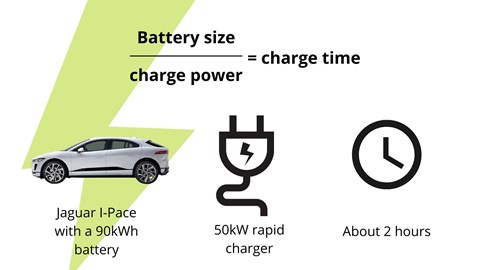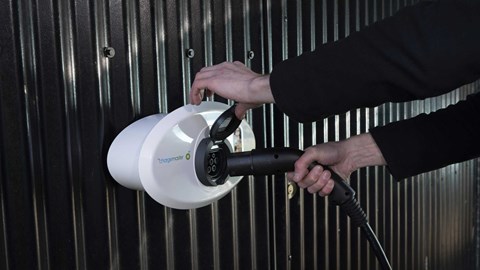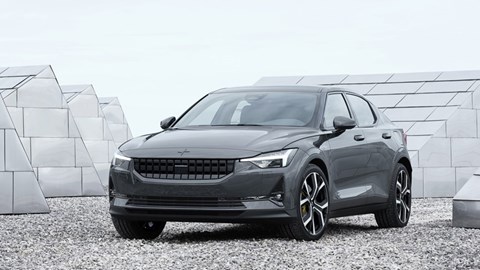► How many hours or minutes does EV charging take?
► Why charging at home is slower but more convenient
► How battery tech will improve
If you’re considering buying an EV, one of the first questions you’ll ask your local dealer will be “how long does it take to charge?” On this page, we’ll explain how long it takes to recharge an electric car, so you can decide whether an electric car would suit your lifestyle. Read on for all the details.
Calculating charge times
Charge times differ according to the type of car, the size of its battery and the charging system it’s connected to, but there’s a simple equation you can use to figure out how long you’ll need to wait. It looks like this:
Battery size ÷ charging power = charge time.
For example, if you stop to charge a Jaguar I-Pace at 50kW charging point, its 90kWh battery pack should be completely replenished in around two hours.

Types of chargers
The UK has a network of more than 27,000 electric vehicles chargers. Amongst those, there are three main categories. We explain their traits below and outline the difference each will make to your car’s charge times.
Rapid chargers (up to 350kW)
The terminology isn’t official, but the term ‘rapid charger’ usually applies to a charging point capable of kicking out between 50kW and 350kW of power. Rapid chargers (including Tesla’s network of Superchargers) also have their own cables or tethers.
Most EVs connect to rapid chargers via a Type 2 or CCS plug, although a few models (such as the Mitsubishi Outlander PHEV) use the larger outdated CHAdeMO cable. At the time of writing, Tesla’s Supercharger network is exclusive to Tesla drivers, although it’s about to be opened to all EV brands.
Naturally, your car will charge the fastest using this system. However, it’s worth bearing in mind that a most electric cars have a limit to the amount of power they can receive when charging. So, if your car can only accept up to 100kW of power, you won’t reap the benefits of connecting to a 350kW charging port.
How long will it take to charge an EV using this system? Well, the Jaguar I-Pace can charge at up to 100kW so, if we use our equation above (and the optimum charging conditions are met), it should take just under an hour to completely recharge.
Fast chargers (7kW and 22kW)
These are used in public charging points and home wallbox chargers. Home chargers tend to be 7kW units because that’s the maximum amount of power you can safely pass through a domestic single-phase electricity supply. More on that later, though.
Most public chargers are untethered, meaning you need to use your own charging cable to top up. Charge times are also much slower than a rapid charger – our Jaguar I-Pace will need to be plugged in for around four hours to completely recharge.
Slow chargers (3kW-5kW)
Slow charging is done with either a Type 1 or (more commonly these days) a Type 2 cable connected to a dedicated EV wallbox or a three-pin household socket. Public slow chargers (like the ones found in lamp posts around London) might be able to supply around 5kW, but a regular plug socket will only provide 2–3kW.
Because they take so long, slow chargers aren’t best suited to public spaces. They’re generally used at home by people who charge their small EVs overnight. The power trickles into the battery, but owners can wake up to a full charge.
How much does it cost to charge an electric car?

Methods of charging
Top-up charging
This is what people generally do when using the public chargers. We’ll stick with the i-Pace and 50kW rapid charger scenario for the sake of simplicity.
Let’s say you wanted to know how much range you would get from plugging in the Jag at a motorway service station for 30 minutes. In that time, using that charger, the i-Pace would gain about 90 miles of range. If it was connected to a 22kW fast charger, the amount of range added would drop significantly to about 12 miles.
Home charging
The overwhelming majority of EV owners charge their cars overnight at home. As we mentioned, the easiest but slowest means of domestic charging is by plugging an EV into a regular home socket. However, 7kW fast chargers are easy to get installed, and affordable thanks to the government’s Electric Vehicle Homecharge Scheme. The EVHS grant contributes up to £350 per charger installation, covering a maximum of two chargers per property.
When charging an electric car at home, amps, volts and watts are useful in working out how long it takes to charge a car with a given charger. Chargers give you a power output figure, but it helps to understand how it has reached that figure.
Amps (or Amperes) are a measure of electrical current, the amount of electricity flowing through a circuit. Voltage is the muscle; it determines how much current can be shoved through an electrical circuit. And Watts are the unit of measurement for the power that results. The relationship between these three is represented by this equation:
Power = Current x Voltage
A 7.4kW home charger has a voltage of 230V (standard home voltage) and current of 32 amps (230 x 32 = 7360 watts/7.4 kilowatts). 7.4kW chargers are ideal for overnight charging, even for EVs with big batteries. Plus they only require a single-phase power supply like domestic properties tend to have.
You can upgrade to a 22kW charger at home if you really want to, but it means installing a three-phase power supply, which can be very expensive. The 3kW slow-charging method isn’t really feasible for high-mileage drivers: any EV with a large battery – such as a Ford Mustang Mach-E or an Audi e-Tron – will take days to charge rather than hours.
There are a number of companies that offer home chargers such as Wallbox, Pod Point, BP, and Rolec. Additionally, car manufacturers such as Tesla and BMW offer their own domestic units, and some manufacturers will include installation within the purchase price.
While home chargers are undoubtedly useful and easy, they require a garage or a driveway. Those of us whose cars live outside our houses (sometimes a little down the street if a visitor has nicked our spot) struggle with practical issues of draping a charging cable out to the car.
Watch out for the cold
The weather can seriously tamper with some of the maths above. Batteries don’t like the cold, and wintery temperatures can slow down the charging rate and reduce the overall range of an EV. A study conducted in 2018 by the Idaho National Laboratory looked at the effects of temperature on a fleet of Nissan Leaf taxis. They found that the cars being charged at 25°C for 30 minutes gained 36% more charge than those being charged at 0°C for the same length of time.

The future of EV charging
While chargers are getting better, current battery technology is holding some EV buyers back. For many, it still takes too long to charge an EV compared to a petrol or diesel car. But things are changing.
Israeli company StoreDot has begun production of its extreme fast-charging (XFC) batteries. StoreDot’s aim is for these batteries to be able to gain 100 miles worth of charge in five minutes by 2025 – that’s twice as fast as a 150kW charger can manage. It’s serious business too, having attracted investors including Daimler and BP. StoreDot’s batteries are still lithium-ion, which means they still bear the issue of range and particularly weight. Nevertheless, it represents a promising intermediary that will make EVs more attractive to buyers while a better battery solution is developed.
StoreDot is far from alone in its quest for improved battery technology. All the world’s car makers are reorganising themselves to focus on EV R&D. In addressing people’s environmental and humanitarian concerns over the use of cobalt in lithium-ion batteries, Panasonic revealed its new low-cobalt batteries early in 2021, with the intention of not using the rare mineral at all in its batteries within the next couple of years. This will make car batteries not only more eco-friendly, but cheaper too. New and improved batteries are a case of when, not if.